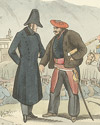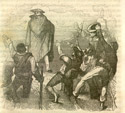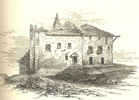19th Century´s militar history in the Basque Country
TOMAS ZUMALACÃRREGUI. (1788-1835)
 Zumalacárregui was born in Ormaiztegi in December 1788. The son of an Idiazabal clerk, he decided to follow in his father's footsteps and hence received an education. He was studying in Pamplona when the Napoleonic Invasion changed his destiny. He joined the guerrilla band of Jáuregui “The Shepherd” in 1812. His participation in this war ended at the Battle of San Marcial, for which he was awarded a medal.
Zumalacárregui was born in Ormaiztegi in December 1788. The son of an Idiazabal clerk, he decided to follow in his father's footsteps and hence received an education. He was studying in Pamplona when the Napoleonic Invasion changed his destiny. He joined the guerrilla band of Jáuregui “The Shepherd” in 1812. His participation in this war ended at the Battle of San Marcial, for which he was awarded a medal.
He ended the conflict with the rank of captain and decided to continue with his military career. He was posted to various destinations until the 1820 Revolution, when he was removed from command due to his sympathies with the more conservative sectors of the militia.
In 1822, he joined the Royalist rebels under the orders of Genaro Quesada, leader of the Navarre uprising. He fought against the Liberals as commander of the Second Battalion of Volunteers of Navarre. When the European powers sent the "100,000 Sons of Saint Louis" to put an end to the Spanish Liberal experience, he joined them under the command of the Duke of Angouleme, taking part in the siege of Lérida in October
 The following year, he organised the Battalion of Royalist Volunteers of Navarre while participating in the repression of the Liberals in the military commission of Pamplona. He continued in his military career and was posted to Huesca, Toledo, Soria, Zaragoza and Madrid. In 1832, he was appointed military governor of El Ferrol. His ambiguous action in the frustrated absolutist insurrection that led to the fall of the conservative government of Calomarde, brought him before the military tribunals. Though he was absolved, he was removed from command in the last year of the reign of Ferdinand VII. He requested retirement to Pamplona and it was there that he found himself on the death of the Monarch and during the uprising of the supporters of Don Carlos.
The following year, he organised the Battalion of Royalist Volunteers of Navarre while participating in the repression of the Liberals in the military commission of Pamplona. He continued in his military career and was posted to Huesca, Toledo, Soria, Zaragoza and Madrid. In 1832, he was appointed military governor of El Ferrol. His ambiguous action in the frustrated absolutist insurrection that led to the fall of the conservative government of Calomarde, brought him before the military tribunals. Though he was absolved, he was removed from command in the last year of the reign of Ferdinand VII. He requested retirement to Pamplona and it was there that he found himself on the death of the Monarch and during the uprising of the supporters of Don Carlos.
In October, he joined the rebels and obtained his first commanding position, initially for Navarre and, shortly afterwards, for the whole of the Basque country. He had magnificent organisational skills, as shown by the transformation of his random guerrilla groups into an army capable of fighting top Spanish troops, all in just a few months. While he was training his troops, he used guerrilla tactics to fight the most prestigious generals defending Isabel II. Following the arrival of the Pretender in July 1834, who confirmed him as the military chief of his supporters, he defeated Rodil, Espartero, Carondelet, O'Doyle, Cordova, Espoz y Mina and Valdés, the crème de la crème of the Spanish army, all within a year.
 In April 1835, he signed the Eliot Convention, named after the English ambassador sent to regulate the bloody civil war and as a result of which, the contenders began to take prisoners and respect the injured. The signing of this Convention also implied international recognition of the Carlist army.
In April 1835, he signed the Eliot Convention, named after the English ambassador sent to regulate the bloody civil war and as a result of which, the contenders began to take prisoners and respect the injured. The signing of this Convention also implied international recognition of the Carlist army.
After defeating Espartero at Descarga and taking Ordizia, the Liberal troops took refuge in the capitals, leaving almost all the rest of the Basque Country in Carlist hands.
 In June, the Pretender ordered him to try and take Bilbao. At the start of the siege, Zumalacárregui was wounded in the knee and asked to be moved to Cegama to be treated. Although the doctors who attended him did not consider the injury to be serious, he died as a result of his wounds nine days later.
In June, the Pretender ordered him to try and take Bilbao. At the start of the siege, Zumalacárregui was wounded in the knee and asked to be moved to Cegama to be treated. Although the doctors who attended him did not consider the injury to be serious, he died as a result of his wounds nine days later.

